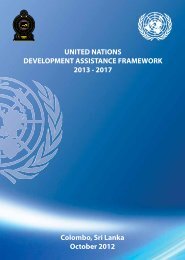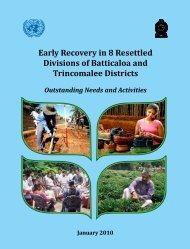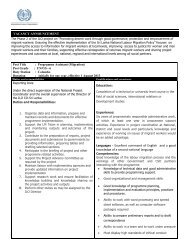Sri Lanka Human Development Report 2012.pdf
Sri Lanka Human Development Report 2012.pdf
Sri Lanka Human Development Report 2012.pdf
Create successful ePaper yourself
Turn your PDF publications into a flip-book with our unique Google optimized e-Paper software.
twice the rate for the economy as a whole. While the<br />
unemployment rate for the educated has been a concern<br />
to policy makers for decades, the problem remains<br />
unresolved, and in particular, high youth unemployment<br />
rates remain of special concern.<br />
In 2010, across provinces with available data,<br />
unemployment was highest in the Southern, Central and<br />
Eastern provinces in that order, all of which recorded<br />
rates above the national average (see Tables A20 and A21<br />
for details). North Central, Western and Uva provinces<br />
recorded the lowest unemployment rates. This is explained<br />
in the Western Province by the fact that it contributes<br />
close to half of national GDP, and in the North Central<br />
and Uva provinces in part due to the high prevalence of<br />
unpaid or very poorly paid family workers. Compared to<br />
the national average of 10.4 percent for this category, the<br />
proportions in these two provinces were 24.2 and 21.5<br />
percent, respectively. Both have a high dependence on<br />
agriculture as the major source of employment.<br />
The Government employs about 14.3 percent of workers;<br />
the private sector employs 41 percent. Another 42 percent<br />
are self-employed or unpaid family workers, mostly in<br />
low-productivity agriculture.<br />
<strong>Sri</strong> <strong>Lanka</strong>’s relatively low unemployment rate depends<br />
on how an employed person is defined. Since more than<br />
a third of the labour force works in low productivity<br />
agriculture and other poor quality jobs, low unemployment<br />
is not necessarily a synonym for good employment.<br />
Other factors that influence labour market performance<br />
include available job opportunities, working conditions,<br />
remuneration and the mobility of workers.<br />
Available evidence indicates that <strong>Sri</strong> <strong>Lanka</strong> faces both the<br />
lack of ‘good jobs’ in the formal sector, and a mismatch<br />
between the skills of the educated and those demanded by<br />
the labour market. 202 The lack of language and technology<br />
skills poses major constraints for seekers of whitecollar<br />
jobs created by the private sector since economic<br />
liberalization. 203 According to Hettige and Salih, the<br />
emphasis on monolingual education in Sinhalese has<br />
divided the society into those who speak English well and<br />
those who do not. 204 Language barriers, they note, increase<br />
ethnic divisions by limiting young peoples’ access only to<br />
those jobs using their mother tongue.<br />
Further, because the economic marginalization of<br />
educated youth is common to all ethnic groups, most<br />
of those who do not speak English well look for jobs<br />
in the public sector. The tradition of providing public<br />
sector employment for unemployed graduates practiced<br />
by successive governments has in fact created awkward<br />
incentives. People with degrees wait for public sector jobs<br />
for more reasons than one: competence in English is not<br />
usually a requirement, the working days are shorter, and<br />
the benefits are better. 205<br />
Labour force participation rates are particularly low<br />
for women. Among districts with available data, the<br />
rates climbed above 40 percent only in Nuwara Eliya,<br />
Anuradhapura, Badulla and Moneragala districts, the only<br />
ones in which the agricultural share of employment is<br />
above 50 percent. This suggests that a large share of female<br />
employment is in this sector (Figure 5.2). The low labour<br />
force participation of females in Ampara, Trincomalee and<br />
Batticaloa may be due to cultural reasons, given the high<br />
proportion of <strong>Sri</strong> <strong>Lanka</strong>n Moors, who are mostly Muslims.<br />
Figure 5.2: Female Labour Force Participation Rates and Agricultural Employment<br />
by District, 2010<br />
Note: Total excludes the Northern Province.<br />
Source: Department of Census and Statistics of <strong>Sri</strong> <strong>Lanka</strong> 2010a<br />
82<br />
sri lanka <strong>Human</strong> <strong>Development</strong> report 2012






